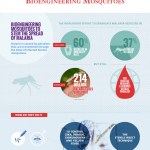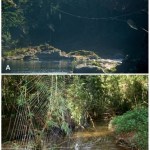bioengineering
I get a lot of "infographics" and many are quite good. But this medium has become a vehicle for commercial advertising. So, some company comes up with an info graphics, maybe makes a good one, sends it around to the bloggers and such, and thier name, somewhere down there near the bottom, gets around. I don't mind the commercial aspect too much, but unless I'm able to vet the graphic, I can't post it, I don't generally have time or resources to do that, so I therefore ignore them.
But this one I'll post because it looks interesting and is produced by a university. Also, we often discuss GMOs…
This is just awesome:
A strain of Escherichia coli bacteria can now solve [sudoku] puzzles
[...]
"Because sudoku has simple rules, we felt that maybe bacteria could solve it for us, as long as we designed a circuit for them to follow," says team leader Ryo Taniuchi.
The mechanism is ingenious and yet straightforward at the same time.
Basically, they have 16 different strains of bacteria, with each initial strain representing a spatial coordinate on a 4x4 grid. Each bacterium has a "4C3 leak" system, which is a chunk of DNA that the team designed that has 4 possible outputs. Depending on…
There was some big news yesterday in transgenic silk from Notre Dame and the University of Wyoming, where scientists have genetically engineered silkworms to produce silk that is a mixture of spider silk and the regular silkworm stuff. Silkworms produce the strong and versatile silk that is used to make clothes, but spiders produce silk that can be much stronger and much more elastic. Spiders, however, don't like to be grown in huge factories and don't make easily harvested cocoons like silkworms, so gathering even small amounts is very difficult (here's a fun how-to for collecting spider…
Silks are incredible protein fibers produced by many different species of insects. Besides their use in making versatile textiles, silks are currently used in many different medical and engineering applications, from sutures to tissue engineering scaffolds to flexible electrode brain implants. Since I love fabrics and I'm interested in what biological engineers can do with biomaterials, I recently started working on a fun side project to raise and engineer silkworms, the animals used in industrial silk production around the world. We're having a lot of fun learning about silk and how to raise…
With health care costs growing without bounds, the medical devices industry and President Obama are hard at work. Not hard at work reducing costs. Hard at work convincing us that the solution to the cost crisis is more technology. Right, Mr. President. And John McCain is a maverick and Sarah Palin is a genius. Almost everyone else believes advanced technology is a significant driver of health care costs and the idea that it will drive down costs is not just a fantasy but steaming pile of crap. That doesn't mean there's no room for innovation to lower costs. On the contrary:
Nobody knows…
The Department of Homeland Security (DHS) Secretary Janet Napolitano is asking academics to work with her agency to develop "innovative initiatives" to protect the nation from terrorist threats. This is what I would call a faith-based initiative, in this case, faith in the technological fix. DHS could certainly use some help. It's one of the most clueless and incompetent agency in the federal government. But I don't think the answer to the problem is going to be found in nanotechnology, computer science or micrcomputer circuitry:
The DHS noted that the cooperation between its departments and…
A Reuters piece under the headline, "Biotechnology Boom Raises Security Fears: Mild Diseases Could Be Turned Into Deadly Ones, Experts Caution" we see the biotech Frankenstein/terrorist bogeyman raised once again by "experts" in the area at a scientific conference in Casablanca. The weekend conference was run by a tiny group (budget of less than $250K) with a big name, the International Council for the Life Sciences (ICLS). Their sole mission is biological biosecurity, so it is understandable that their conclusion is that this is a big problem. But is it?
On the surface the proposition is…
There is as yet no pandemic bird flu vaccine but there are a lot of potential vaccines. The recent fiasco involving Baxter International (here, here) involved one in development. There are many more. They employ old and new technologies and are in various stages, a few in early clinical trials. Many more are in the pre-clinical (animal or test tube) phase, although they are frequently reported in the news because the company developing it wants to attract support or publicity. I often don't pay attention to announcements of "breakthroughs" that are successful in mice. Many vaccines work in…
There is a story on the wires today about an upcoming Lancet article describing the case of a young Columbian woman whose failing airway was replaced by a bioengineered airway whose cells were cultured from adult stem cells obtained from the patient's bone marrow. Since there is as yet no scientific paper, I got these details from a press release from the University of Bristol, one of four participating European universities in this unique case (the others were in Barcelona, Padua and Milan).
The 30 year old patient's main airway (the lower trachea) and left main stem bronchus (one of the two…
A story in CIDRAP News by the always excellent science journalist Maryn McKenna provides food for thought:.
A flu vaccine manufacturer's decision not to build a US facility has highlighted the perpetual mismatch between flu-shot supply and demand--and the reality that the mismatch may undermine plans for pandemic flu vaccines.
On Tuesday, Solvay Pharmaceuticals Inc. of Marietta, Ga., announced that it was canceling plans to build a US flu-vaccine manufacturing plant, a $386 million project that Birmingham, Ala., and Athens, Ga., have been competing for. The plant would have made both seasonal…
One of the effects of high gas prices is to encourage people to use bicycles. This also includes the police, where some jurisdictions are taking cops out of cruisers and putting them on foot or on bikes. Bike police (and bicycle messengers, people who use their bikes in crowded urban areas to endanger pedestrians), spend much more time in the saddle than most, other than professional racers and bike fanatics. A new study in the Journal of Sexual Medicine says the continual pressure on thei perineum is causing genital numbness in males. The culprit seems to be the nose on the traditional bike…
We take for it granted that technology can be used to tag objects in various ways, useful and otherwise. The anti-theft devices used on retail clothing stores are a familiar example. Radio Frequency Identification Devices (RFID) are used for this purpose as well as for security access. I have a device like that on my windshield for automatic highway tolls on the turnpike. Hospitals also have a strong interest in keeping track of lots of items like pharmaceuticals, equipment or even ordinary sponges used in surgery. Counting and keeping track of sponges is routine so none are inadvertently…
Many years ago -- about 40 to be exact -- I was working as the only medical doctor in a bioengineering research laboratory in a famous technological university. A lot of what was done there involved speech synthesis (one of the first reading machines for the blind using text to speech recognition) and also some digital image processing. One of my interests was in radiology (the medical specialty of reading x-rays) and I was doing some research in that area. X-rays of the chest were usually taken in threes: the "posterior-anterior" (PA) view (back to front), the lateral (through the side) and…
While we are all waiting for the other shoe to drop and a nasty, rip roaring flu pandemic to come rushing down the tracks at us, lots of companies have jumped into the pandemic vaccine sweepstakes. Reuters reports that at least 16 companies are testing flu vaccines and probably even more are involved in some technical aspect of vaccine production. That's good, although whether it will make any significant difference except around the margins remains to be seen. Timing is everything.
Meanwhile, though, work is going forward on many vaccine fronts. The one to hit the PR wires today is a report…
Things are changing. And here's some evidence. This is a great story (hat tip Boingboing). It's about a new test for African sleeping sickness (trypanosomiasis), a disease carried by the tse-tse fly that afflicts an estimated 66 million people in 36 countries. Not a nice disease:
At first, the main clinical signs of human trypanosomiasis are high fever, weakness and headache, joint pains and pruritus (itching). Gradually, the immune defence mechanisms and the patient's resistance are exhausted. As the parasite develops in the lymph and blood of the patient, the initial symptoms become more…
Note to Senator Larry Craig. Now you can have "intimate contact with an anonymous stranger [in a public toilet] without the associated awkwardness of verbal discourse". No toe tapping required. Just look for the yellow color in the new thermochromic toilet seat (h/t Boingboing).
This beauty glows when it's warm, so that you can always sit on a toilet seat recently vacated by a stranger and get that nice warm feeling of "the other." Just look for the yellow (hot) Springfield Oval. And enjoy. Here's a pic:
Forty years ago I was the only doc in a bioengineering lab in a famous technical university. We had our own computer -- it took up a giant room -- and had attached to it a rare device in those days, a scanner for converting transparencies to computer readable form. It was really a cathode ray tube with a sensor on the other side of the transparency. The CRT scanned and the sensor sensed and an analog to digital converter converted. About that time I got interested, along with an engineering colleague, in taking two-dimensional x-ray images, which were really projections or shadows of the…
One of the enduring mysteries is what causes traffic jams. Sometimes it's obvious -- sort of. I remember having to make a daily trip from New York to Bellevue Hospitals in New York down FDR Drive. At one spot the three southbound lanes suddenly widened into five lanes because of some construction and then, after about 100 yards, narrowed again to three lanes. If you didn't know better you'd think the extra capacity of the roadway wouldn't be a problem but in your mind's eye you can see exactly what happened. All those cars that filled up the extra space had to reconverge to three lanes. The…
Indonesian Health Minister, Siti Fadilah Supari, has reiterated her refusal to share isolates of H5N1 virus (it's unclear if this is her decision alone or is the considered decision of the Indonesian government). This came at the current inter-minsterial conference on bird flu on underway in Delhi (how many of these conferences are there, anyway? It seems like every week there's another one.) Her demand is that every isolate have a Material Transfer Agreement (MTA) requiring a statement each time the isolate is shared with another laboratory, stating it is only for diagnostic purposes and not…
Carnegie-Mellon is a great university and when it comes to robotics and computer science is always on the cutting edge. But does that cutting edge have to be so sharply lethal?
Unmanned aircraft are showing up in the skies more often and today the US Army awarded $14.4 million to Carnegie Mellon to build a remote-controlled unmanned tank.
A certain amount of the award will go toward significantly improving the Crusher, a 6.5-ton unmanned support vehicle Carnegie engineers developed in 2006 in conjunction with DARPA. Since its introduction, the Crusher has demonstrated unparalleled toughness…

